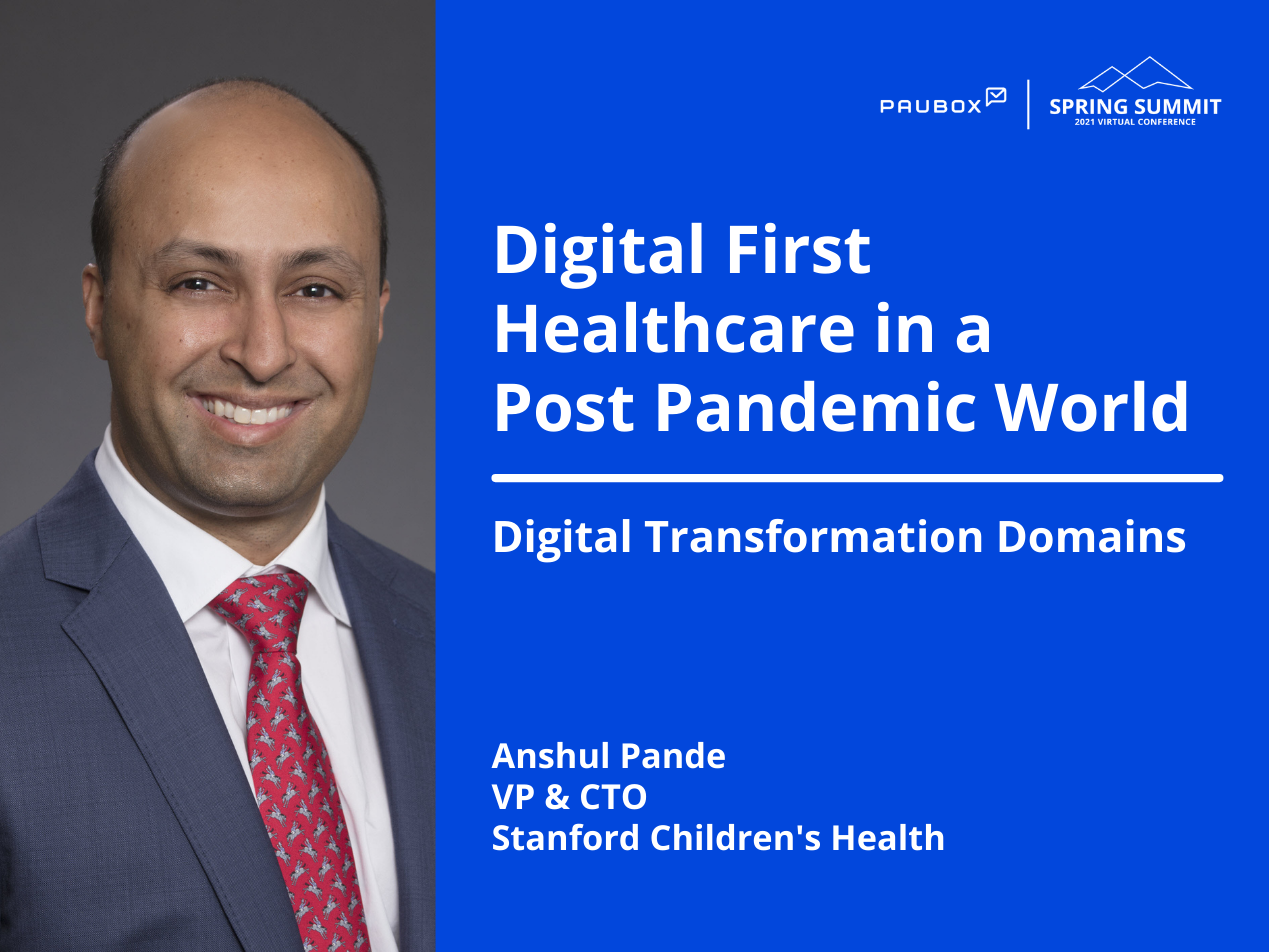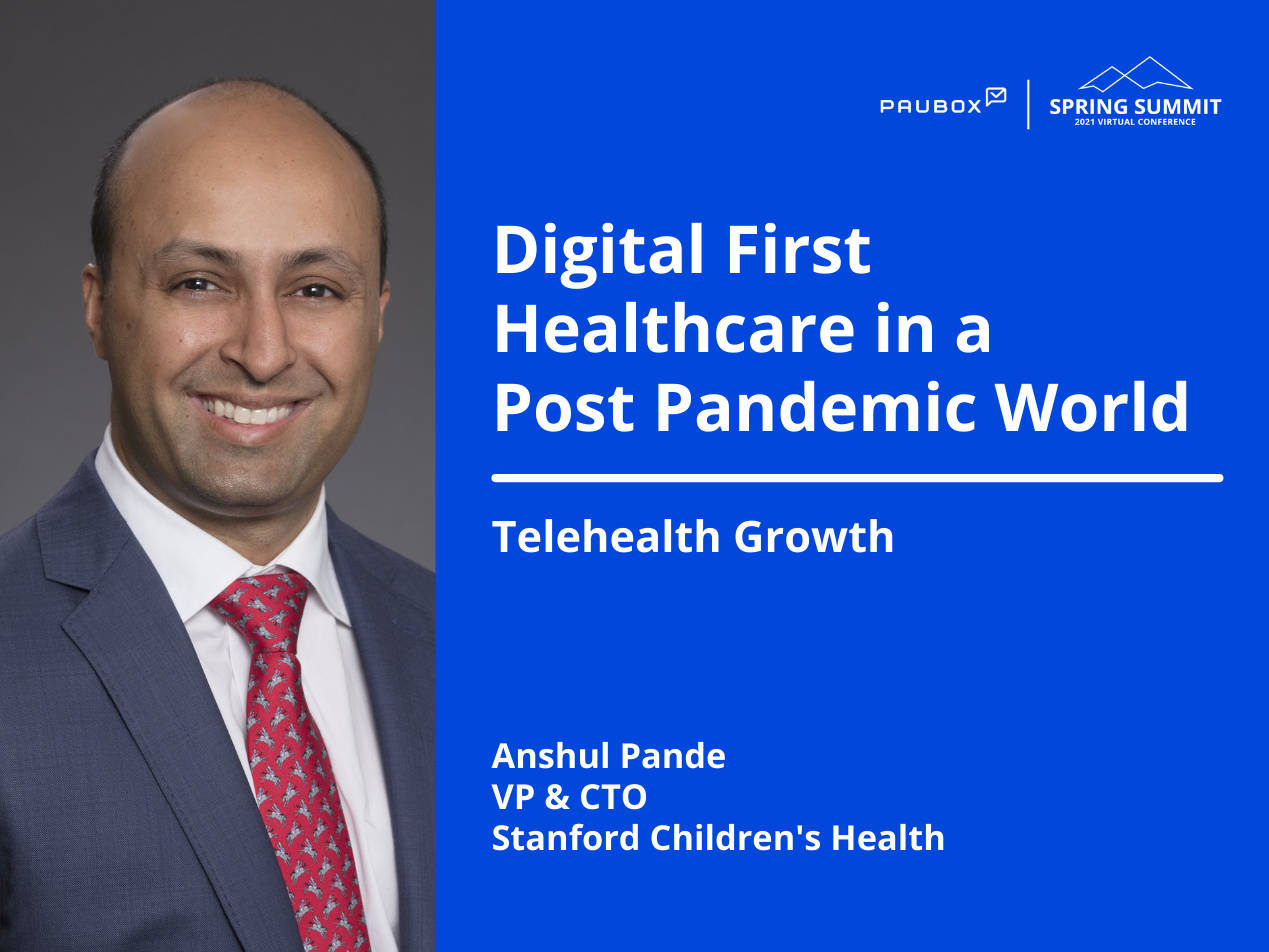3 min read
Anshul Pande: Digital transformation domains at Stanford Children’s Health | Paubox Spring Summit
Hannah Trum April 07, 2021

The opening session from Paubox SUMMIT 2021: Secure Communication During a Pandemic. Pande is the vice president and chief technology officer of Stanford Children’s Health, the only healthcare system in the San Francisco Bay Area dedicated to pediatric and obstetric care. It is also one of the few in the country. As CTO, Pande is responsible for all aspects of technology selection, deployment, and delivery for Children’s Health.
Pande explores what digital transformation means in a post-pandemic world and how organizations worldwide can focus on technology as a support rather than a crutch.
Anshul Pande: Spring of 2019, one of the things me and my teams were working on with our clinicians was, from a digital perspective, how do we connect our patients and our families better. And, and this was truly important for us because we are a pediatric health system.
Kids, by and large, are pretty healthy. So it’s a small population of kids that are sick who have genetic conditions or knee transplants that we need to take care of. And there are certain things which we do better than anybody else. For solid body transplants, we are one of the best centers in the country, there are a couple of things on the heart side that we do, where we’ve been so successful that in the last 20 years for certain procedures, we haven’t seen any anybody die. So zero mortality.
And what’s happened is now we have adults who we saw since they were born through some of our heart programs that are in their early to mid-20s. And they come to us instead of an adult cardiologist, because we know their entire history, we know their complexity. And we know that journey in terms of how their body has healed and how their heart has grown. So you know, it’s surprising when you get into a children’s hospital and see full-size beds with adults laying in them. That’s us.
But in 2009 teen, when we were starting to think about digital this is the tagline we came up with this transformation is an experience transformation. It’s not new, it’s not something we created, we co-opted it. But the intent was how do we focus on the experience? And then how do we use digital to completely transform the experience of our patients and their families. And what we came up with were four domains, four domains to focus on for our entire digital transformation journey.
On the one side, we focused on patients, how do we connect with them? How do we engage them? How do we ensure that they have access to all the complex healthcare options and resources that we provide? How do we answer their questions? And then how do they connect back to us when they need help?
Then we looked at providers. And in particular, if you are in the US, you know that there’s a shortage for the number of Doc’s, we are not producing as many from the colleges that we need. burnout is a big issue, especially in the last several years, as we have started to measure it and understand the implications of it.
Also, the US population is aging pretty rapidly and over the coming decades. And two, it will put a tremendous amount of pressure on our health system. So taking care of our providers, their mental health, so that they don’t burn out was extremely important. Anything we can do to improve their experience as they practice medicine was paramount. From a business processes perspective, you know, there’s always this push to continuously improve, to optimize to reduce costs, and pull them out of the system.
Us healthcare is really expensive. And whatever we can do from an administrative perspective to reduce the cost is, is phenomenal. So simplifying things reducing handoffs, and automating as much as possible was really a big focus for us. Finally, growth. How do we look at using digital tools to change how we look at our markets. So a good example of this was, we started doing analytics to look at where populations are growing in the barrier. And if you’ve been in Bay Area, when we were deciding where we open our next clinic we were looking at in the city, or in East Bay.
And then we looked at the analytics of where populations of young people are growing so that someday they will get married enough kids.
We saw that East Bay had the biggest growth coming out and part of it is new housing coming in that market, which is more affordable. And the fact that the city is pretty saturated. And so when we were building clinics, the next clinic came up and as we looked at these options, the population analytics pushed us towards building more in East Bay than in the city as an example. Early on, this is what a set of projects look like for us in all of those areas. Everything from video visits, to login optimization to speech recognition for the providers to RPA, is to second opinions from a growth perspective.
Watch every minute of Anshul Pande's session here.
Learn more about Paubox Spring Summit, Secure Communication During a Pandemic.
Read a full recap of Paubox Spring Summit. Learn more about Anshul Pande.
Subscribe to Paubox Weekly
Every Friday we'll bring you the most important news from Paubox. Our aim is to make you smarter, faster.



